Ruth Bader Ginsburg – A Note of Appreciation from a Diabetes Nurse
Today, let’s celebrate Supreme Court Justice Ruth Bader Ginsburg and consider the impact of her legacy on our lives.
In spite of a tough childhood filled with loss and numerous obstacles through her adult life, Ruth Bader Ginsberg (RBG) persevered and became a champion for equality. She believed that equal justice under the law should be applied to every single American, regardless of gender.
As a woman-owned business, I owe a debt of gratitude to this trailblazer. She demonstrated through her actions, that women are equally capable of taking leadership roles, running organizations, and being change agents.
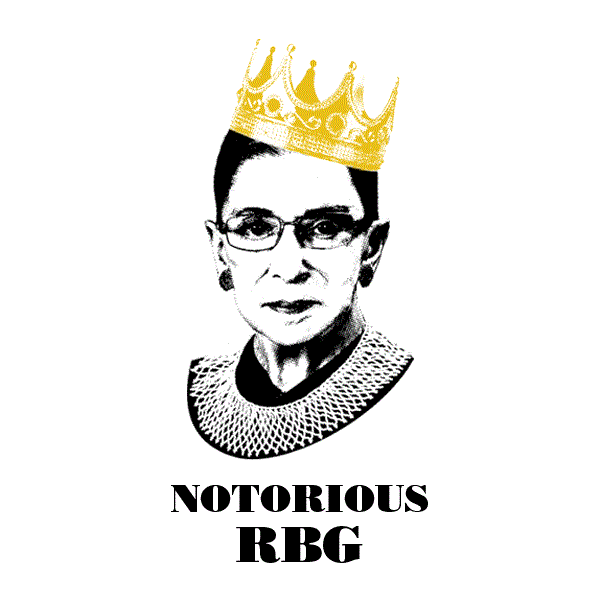
She provides wisdom and guidance for diabetes specialists and advocates.
“Fight for the things that you care about, but do it in a way that will lead others to join you.” – RBG
As a Diabetes Care and Education Specialist for over twenty years, I have personally witnessed the positive changes our community has championed. From making sure recommendations are based on evidence to changing our approach from a compliance model to person-centered education. We have advocated for Medicare Coverage for the Diabetes Prevention Program and won approval.
In the spirit of RBG, we are taking a leadership role in promoting CV disease reduction and bringing technology and resources to underserved communities. We realize the importance of equitable diabetes care delivery and are raising awareness of the social determinants of health. We are breaking down barriers and lifting people up.
We have done all this through careful study, collaboration, research, kindness, and compassion.
Just like RBG, our Diabetes Community realizes we are in it for the long haul and big changes take time.
“Real change, enduring change, happens one step at a time.” – RBG
This determined woman instigated a revolution of thought and legislation. Not overnight, but with slow, methodical determination and intelligence and we are forever indebted to her.
Thank you, Ruth Bader Ginsburg. Even though you have passed, your fire burns brightly.
Coach Beverly
Earth Blessing

Today’s blog provides a moment to pause and acknowledge the pain that the earth and many of us are experiencing from fires, the pandemic and intense weather events. I want to share this blessing with our community and let you know that you are important and treasured.
With affection, Coach Beverly
We Hold the Earth
We hold our brothers and sisters who suffer from fires, illness, extreme weather events and droughts.
We hold all species that suffer.
We hold world leaders to make decisions that support healing of the planet and all its inhabitants.
We pray that the web of life may be mended through courageous actions starting today.
We pray for social justice, empathy and awakening to help our already suffering earth community.
We pray that love and wisdom might inspire my actions and our actions as communities. . .
so that we may, with integrity, look into the eyes of brothers and sisters and all beings and truthfully say, we are doing our part to care for them and the future of the children.
May love transform us and our world with new steps toward life.
Adapted from Innovation Institute Earth Day Blessing
3 Things I’ve Learned While Speaking Spanish
On Fridays, I get to provide diabetes care at a local clinic where about half of the people I see are Spanish-speaking only. We do have wonderful interpreters, but I have a strong desire to communicate directly with my clients and really understand what they are saying, in their language.
My Spanish is getting better, but I keep giving myself permission to appreciate where I am now, with the belief that even at my age, I can keep improving.
Learning Spanish Isn’t Easy
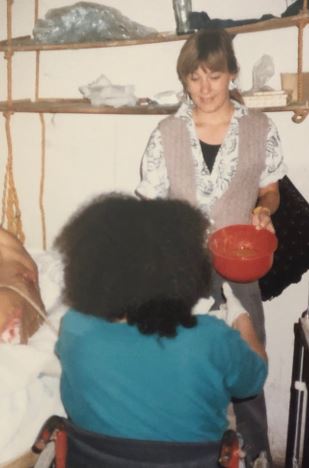
I took a few years of high school Spanish, but never really had a grasp on the language until I signed up to move to a small pueblo in Mexico, in 1987, to volunteer as a rural healthcare worker.
I lived with a local family and helped with daily chores in addition to providing services in the clinic. As part of the “Projecto Projimo”, I helped with everything from cleaning bathrooms to dressing wounds as pictured here. I also attended classes daily in Spanish, to become a “Promotora de Salud”, a community health worker.
Along with learning Spanish, I have gained some other valuable insights that I would like to share.
1. I’ve learned how to be still and listen
For the first few months I lived in Mexico, my Spanish was so bad I was reluctant to talk and embarrass myself.
Instead I did a lot of careful listening and observing.
As with anyone acquiring a new language, my brain was looking for patterns and listening for frequently used words. I studied cognates and learned about sentence structure and common phrases in my textbook, “Donde No Hay Doctor – Where There is No Doctor”, which I would read every night before passing out from mental exhaustion.
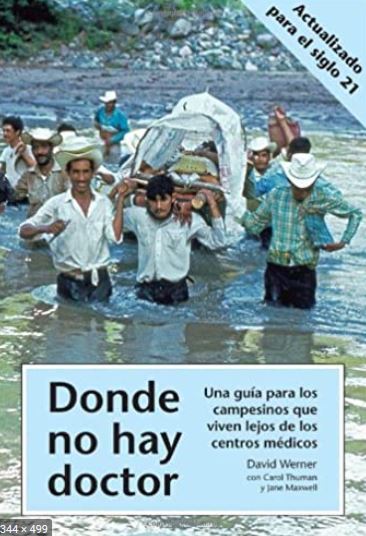
By the third month of living within this new community, I was able to understand most of the questions being asked and respond with rudimentary sentences. Sometimes I could even conjugate in the past tense. That was 30 years ago.
Now, working in the clinic, I have had to dust off my Spanish language skills, that have been languishing in the recesses of my brain for almost three decades. I have committed myself to expanding my Spanish vocabulary and improving my ability to communicate in ways that are meaningful.
When I meet with our Spanish-speaking clients in my current clinic, to fully understand what they are saying, I have to dedicate my whole being to hearing their diabetes stories.
It all starts with listening.
I am completely present to capture all the words they are saying coupled with their body gestures. Sometimes I get so enraptured in everything they are saying, then when they stop, I forget to ask the next question.
In that silence, we have a moment of understanding and togetherness that goes beyond language.
2. The most important phrase to learn
The funny thing is, in spite of knowing lots of diabetes phrases in Spanish and the names of dozens of fruits and vegetables, plus most of the body parts and medical conditions, there is still one phrase that I need to say with each new person I meet.
“No es su culpa” or “It’s not your fault.“
When people share their diabetes stories with me, it feels like there is an invisible burden they are carrying on their backs. This burden is reflected in tears or embarrassment for elevated blood sugars. For many, that burden is best described as shame.
They somehow believe it is their fault they have diabetes.
I reassure them, that diabetes is not their fault. It is a complex interplay between genetics, environment, access to healthy foods, stress, inequities, body weight, and age.
Each one of us knows people who don’t eat healthfully, have extra weight and don’t exercise, who never get diabetes.
Let’s help people let go of the shame so they can move toward engaging in self-care that improves their sense of self and well-being.
Let’s remind them that they are worth it!
3. Offer Grace to those learning English
The outstanding thing I so appreciate is the grace that my Spanish-speaking clients show me.
So many times I can’t remember a vocabulary word, or I will say a phrase in a funny way. There are moments where I stumble and feel bad that I don’t have the ability to accurately express what I am thinking.
No one has ever made me feel bad about my mistakes. They are respectful and just politely ask, “Mande?”, letting me know that they did not understand what I was trying to communicate.
They are simply grateful that I am trying to communicate in their language.
It reminds me to be patient with people who are trying to acquire the English language. Let’s acknowledge the courage it takes to tackle a language that you did not grow up speaking. Let’s offer them grace and the opportunity to practice speaking this new language.
We can also let them know they are safe to make mistakes with us.
Gracias! Coach Beverly
Free Resources
| Please enjoy these FREE resources that we have put together for you: |
|---|

- Diabetes Blog Bytes
- Medication PocketCards
- 10 Steps to Succeed
- CDCES Coach App
- Free Webinars hosted by Coach Beverly
- Question of the Week
- Free Diabetes Article Library
See Full Free Resource Catalog
Sign up for Diabetes Blog Bytes – we post one daily Blog Byte from Monday to Friday. And of course, Tuesday is our Question of the Week. It’s Informative and FREE! Sign up below!
[yikes-mailchimp form=”1″]Figs and Drunken Fig Jam. Happy Monday
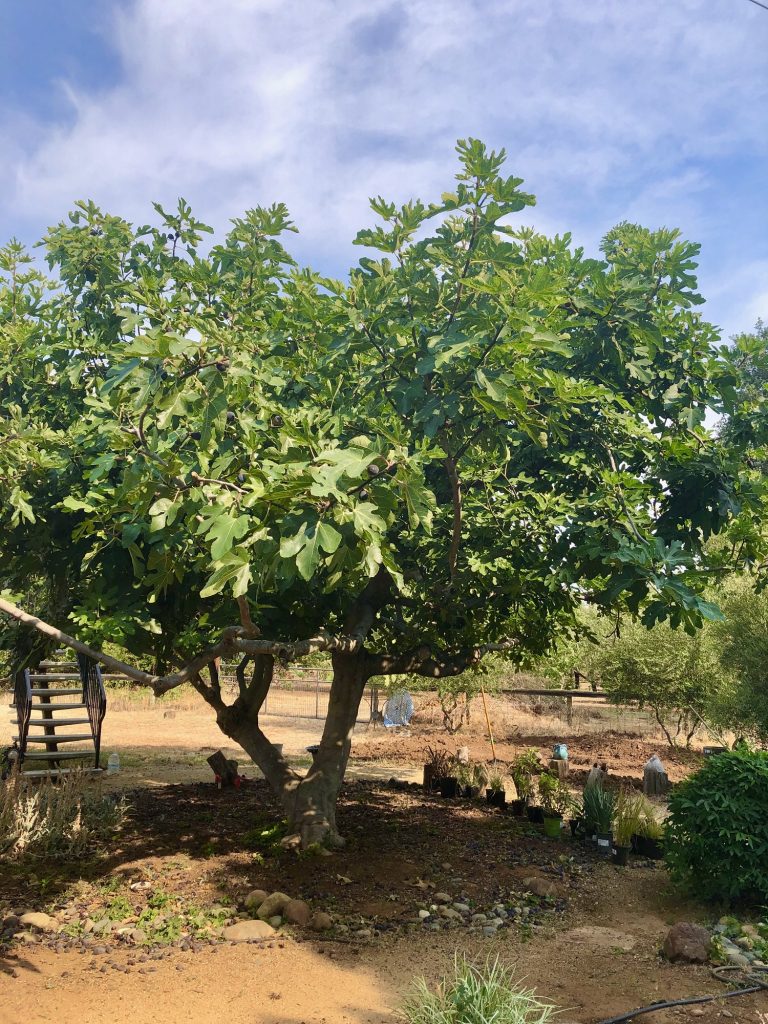
On my 40th birthday, I was gifted a Mission Fig tree that was no taller than my 5″ 7″ self.
The tree loved her new home and grew quickly, spreading out her limbs and gifting us with buckets of sweet fig fruit within a few years.
She is a strong and sturdy tree. My teenagers do pull-ups on her limbs and she has survived all kinds of weather events.
She rebounded after an intense wind storm, where her largest limb snapped off. Overburdened with figs, her trunk broke in half one season. We worried she wouldn’t make it, but that summer she produced even more figs.
When we were planning to build my office eight years ago, the architects told us our fig tree would need to be cut down to make room.
We altered our building plan and moved the location of my office to make room our beloved fig tree.
As a gesture of gratitude, our tree has blessed us with fig “over-abundance” year after year.
With my office doors open in the summer, I hear the birds fighting for the juiciest figs that thrive on her crown. During work breaks, we go outside, stand in her shade and search for the plumpest and biggest figs to eat on the spot and later to bake and top with a dab of goat cheese.
To extend our fig enjoyment through winter and beyond, we collected over 7 lbs of figs and made 9 jars of buttery fig jam.
With virtual coaching from my Aunt Hedy in Canada, I cut up 7 pounds of figs, added some sugar, fresh lemon juice and a generous cup of brandy. I cooked on low for at least four hours to blend flavors and reduce the jam to the perfect thickness. The brandy adds a smokey, caramel flavor to the jam, that my family loves. However, it also tastes great without it.
Here is the recipe for fig jam that I modified by cutting the sugar by one – half and then adding it back as needed for thickening.
Drunken Fig Jam (Coach Beverly’s modified recipe)
You can easily google a recipe with more detailed instructions, but here is the basic idea.
- 4 pounds of figs cut into quarters
- 2.5 cups of sugar
- 1/2 to 3/4 cups of brandy
- Lemon juice to taste (about 1 squeezed).
Put all of the above into a thick pot and mix. Let sit for an hour, stirring occasionally. Then put on a low heat and let simmer for 4-6 hours to reduce to desired thickness. You may need to add a little more sugar for thickening and lemon juice for the right balance of sweet and “lemonyness”.
Then put into sterilized jars and follow usual canning procedures. I always save one jar as a refrigerator jam that we can start enjoying right away.
With all that is going on in the world, I wanted to write a post that is life affirming and voices my gratefulness for the generosity of nature and my fig tree in particular.
Coach Beverly
Sign up for Diabetes Blog Bytes – we post one daily Blog Byte from Monday to Friday. And of course, Tuesday is our Question of the Week. It’s Informative and FREE! Sign up below!
[yikes-mailchimp form=”1″]Accreditation: Diabetes Education Services is an approved provider by the California Board of Registered Nursing, Provider 12640, and Commission on Dietetic Registration (CDR), Provider DI002. Since these programs are approved by the CDR it satisfies the CE requirements for the CDCES regardless of your profession.*
The use of DES products does not guarantee the successful passage of the CDCES exam. CBDCE does not endorse any preparatory or review materials for the CDCES exam, except for those published by CBDCE.
World Breastfeeding Week: Diabetes and Breastfeeding Inequality
Here at Diabetes Education Services, we are excited to celebrate World Breastfeeding Week!
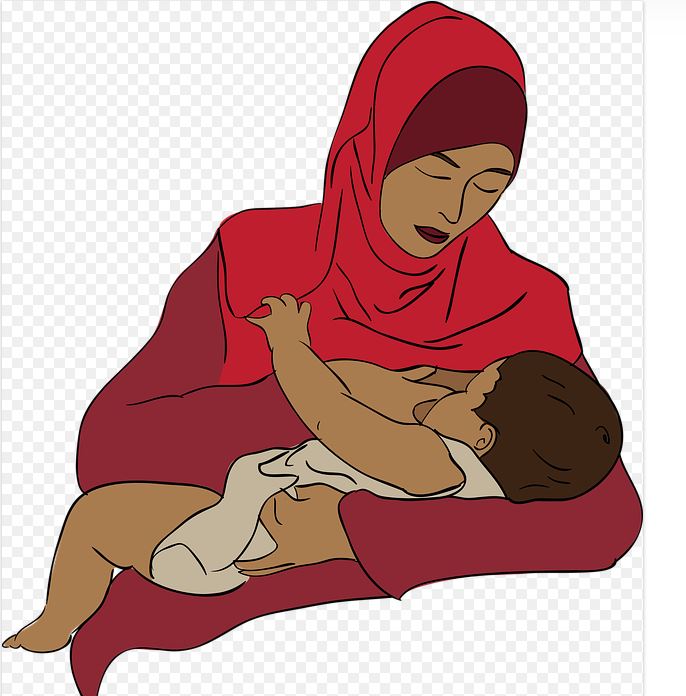
Breastfeeding reduces the risk of future diabetes for mom and baby alike. Studies show that mothers who nursed babies for at least six months were 48 percent less likely to develop diabetes. Yet many mothers, who want to breastfeed, aren’t able to due to a variety of obstacles.
There are myriad benefits to breastfeeding, a fact that’s well-endorsed by upcoming World Breastfeeding Week. This event, which is sponsored by the World Alliance For Breastfeeding Action, focuses on promoting, protecting, and supporting breastfeeding around the globe.
“There could be greater health benefits for women from breastfeeding than previously recognized,” said lead study author Erica Gunderson of the Kaiser Permanente Division of Research in Oakland, California.
Breastfeeding Inequalities
Each year, a new adjacent cause is championed; this year, the climate impact of formula feeding is central to the week-long event. Wisely, the organization makes a point to reflect on breastfeeding inequality as a series of obstacles that must be overcome in order to truly reap the ecological benefits of making this switch.
Below is an infographic that describes the critical issues surrounding breastfeeding inequalities that bring to light an often under-discussed issue. Blog also continues below.

Breastfeeding inequality refers to the disparity in breastfeeding rates that can be observed in socioeconomically disadvantaged areas. Even in developed countries like the United States, demographic areas that fall beneath the poverty line often reveal dismal statistics when it comes to breastfeeding. This visualization breaks down the impact of income, education, and other lifestyle factors on breastfeeding inequality:
For those who’ve simply been watching moms go back and forth online about choosing breast or bottle, learning that some mothers are at a legitimate disadvantage when it comes to breastfeeding can be shocking. Factors like income and partner support play a direct role in the home, but there are other reasons why breastfeeding rates in economically disadvantaged areas are low.
- Low-income, high-stress jobs may offer fewer breaks to pump, no breaks at all, or have a lack of private space in which to do so
- These same jobs are far less likely to offer any kind of paid maternity leave, which often means mom is back to work within weeks of birth
- Hospitals in lower-income areas may not be staffed enough to offer much postpartum support or a lactation consultant
- Mothers may be less connected with their family members and community, and may not be getting positive feedback and support regarding breastfeeding from other mothers in the community
Optimum nourishment at no cost, improved parental bonds, and the possible prevention of future allergies, asthma, obesity, and type 2 diabetes are but a few of the reasons that breastfeeding equality is essential for all families. Though the fight is hard-fought, the health of a generation is a goal worth uniting for.
Written by Guest Writer, Neve Spicer, Founder & Director at Wetheparents.org
Resources
- Wetheparenst.org – Breastfeeding Inequalities article
- “Longer breastfeeding tied to lower diabetes risk for mothers” – Lisa Rapaport for Reuters Health
- Check out this fantastic resource by “Mom loves best” – The 111 Benefits of Breastfeeding – For Babies, Moms & Everyone Else
Watch for FREE or purchase to earn CEs!
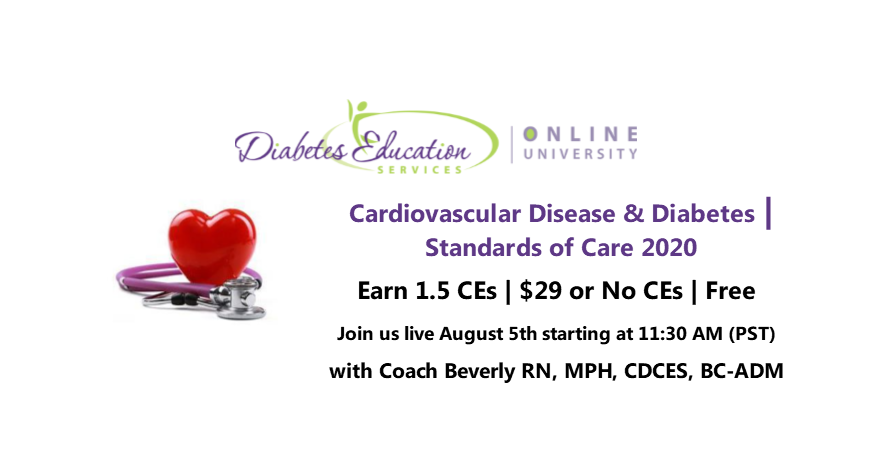
Cardiovascular Disease & Diabetes Standards 2020
Join Live Stream August 5th at 11:30 am (PST)
1.5 CEs | $29.00 or No CEs | Free
Perfect for those planning to take the CDCES or BC-ADM or for those seeking an update.
Diabetes Specialists have a critical role in advocating for CV reduction. Coach Beverly is extending a special invitation to join this webinar on the latest standards for CV reduction.
This webinar will address:
- insulin resistance syndrome and vascular complications.
- impact of vessel disease from the heart to the toes.
- prevention of vascular disease
- strategies to achieve goals of care.
Register for FREE recorded webinar (no CEs).
Sign up for Diabetes Blog Bytes – we post one daily Blog Byte from Monday to Friday. And of course, Tuesday is our Question of the Week. It’s Informative and FREE! Sign up below!
[yikes-mailchimp form=”1″]Accreditation: Diabetes Education Services is an approved provider by the California Board of Registered Nursing, Provider 12640, and Commission on Dietetic Registration (CDR), Provider DI002. Since these programs are approved by the CDR it satisfies the CE requirements for the CDCES regardless of your profession.*
The use of DES products does not guarantee the successful passage of the CDCES exam. CBDCE does not endorse any preparatory or review materials for the CDCES exam, except for those published by CBDCE.
Welcome Jackson and Thank You Robert
My children have been a vital part of my company since before they were born. I remember providing all day lectures with puffy feet and the “waddle” with both of my pregnancies. When they were babies, my wonderful husband would travel with me and the boys to my lecture locations. We would pack up suitcases of supplies, so we could be together and I could breast feed during lecture breaks and in the evenings. I didn’t get much sleep in those days, but it was worth it!
When my boys were in elementary school, they helped assemble DiaBingo (now available for free) and stuff endless envelopes with PocketCards. They have listened to me share my ups and downs of running a business and have been some of my biggest supporters.

I am so proud that Robert and Jackson are official employees at Diabetes Education Services. They are significantly enhancing the services we are able to provide our wonderful community.
They have increased our presence on social media, improved website navigation and are contributing to many behind the scenes enhancements.
After working at the company for the past year, Robert is heading off to college. He spent the last month training Jackson to take over his role. He did a great job preparing his brother, but he also created a Training Manual that we will refer to for years to come. Robert will still be providing consultation on special projects and in case we get stuck in QuickBooks. I am one grateful Mama CEO.
Thank you, Robert, and Welcome Jackson!

Jackson Thomassian, Assistant to the Director of Operations
Jackson is the newest member of our team. He is a rising sophomore and loves playing piano, video gaming with friends, and learning about science.
His job includes activities to make sure our operations run smoothly. He will be answering the phone, fulfilling orders, providing customer service, and completing a variety of quality improvement projects. He is also helping us update our CDCES Coach app with some new exciting features. Welcome, Jackson! We are thrilled to have you join us.
Robert Thomassian, Operations Consultant
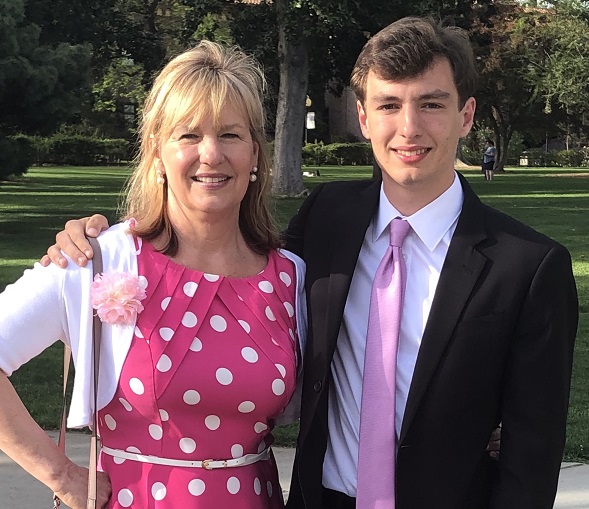
Robert has moved on to attend Southern Methodist University starting in August 2020. He aspires to obtain a Bachelor’s in Business. Robert gained many new skills ranging from social media engagement, to QuickBooks Online to formatting websites and fulfilling orders during his year at Diabetes Education Services. We wish him the very best as he pursues his college education in Texas and provides occasional consultation to our team. Thank you, Robert!
Meet our entire wonderful team here!
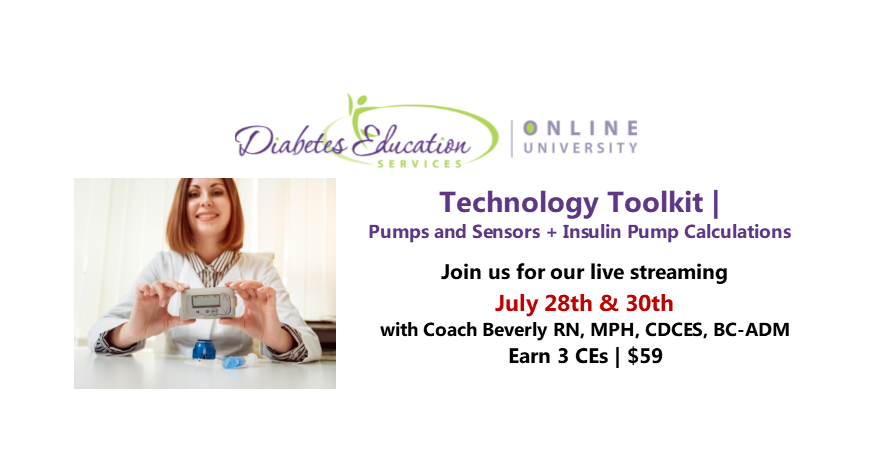
Join us live on July 28th and 30th
3 CEs | $59.00
Perfect for those planning to take the CDCES / BC-ADM or for those who want to learn more about the technology used to manage diabetes.
If you want cutting edge information on diabetes technology, problem-solving, and using a formula to determine appropriate insulin dosing, we highly recommend this toolkit.
Can’t join us live? Recorded video and podcast versions are ready for On-Demand Viewing. All updates webinars are uploaded within 4 hours of the live show ending.
Sign up for Diabetes Blog Bytes – we post one daily Blog Byte from Monday to Friday. And of course, Tuesday is our Question of the Week. It’s Informative and FREE! Sign up below!
[yikes-mailchimp form=”1″]Accreditation: Diabetes Education Services is an approved provider by the California Board of Registered Nursing, Provider 12640, and Commission on Dietetic Registration (CDR), Provider DI002. Since these programs are approved by the CDR it satisfies the CE requirements for the CDCES regardless of your profession.*
The use of DES products does not guarantee the successful passage of the CDCES exam. CBDCE does not endorse any preparatory or review materials for the CDCES exam, except for those published by CBDCE.
Celebrating Congressman John Lewis – In His Words
The world lost a beautiful human on Friday. John Lewis, the 80-year-old legislator grew up the son of a sharecropper, marched alongside Martin Luther King, Jr. and became one of the most celebrated congressmen in Capitol Hill. Known as one of the Big Six leaders of the civil rights movement, he helped shine on a light on inequity and injustice in our society. He sparked change, enacted legislation, and became the “conscience of the congress”.
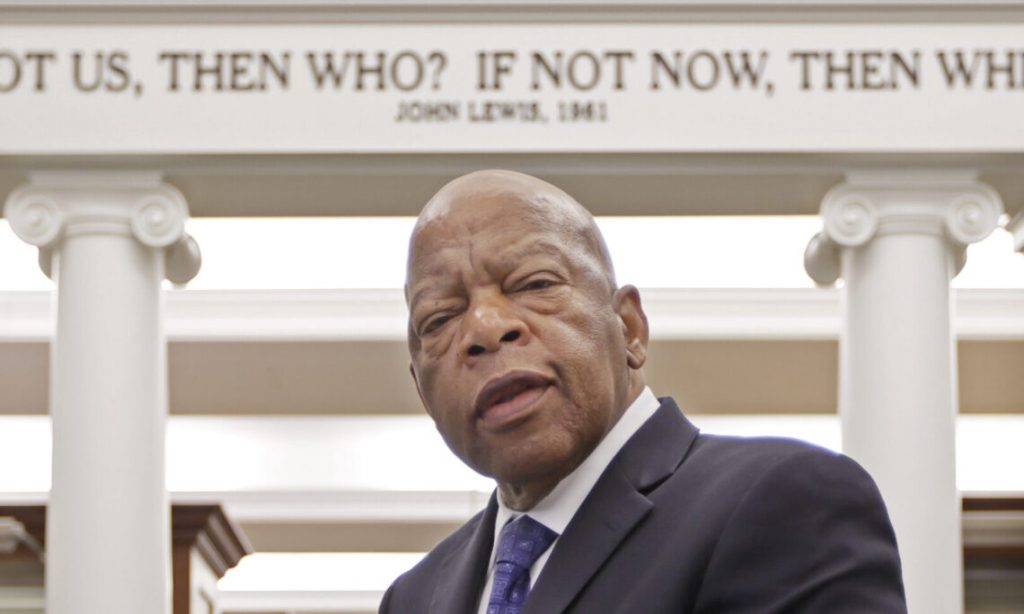
His words speak to me as a Diabetes Specialist and advocate.
We witness people with diabetes struggling with the cost of insulin or fighting the system to receive basic care to maintain their health. In our profession, we have a calling to advocate on behalf of those individuals and fight for better health care delivery systems.
“When you see something that is not right, not fair, not just, you have to speak up. You have to say something; you have to do something.
– John Lewis
We might feel discouraged that change is slow and that we have to jump through so many hoops to make sure people get the care they deserve. Mr. Lewis advises us to be optimistic in our lifelong quest to disrupt these systems by getting into “good trouble.”
“Do not get lost in a sea of despair. Be hopeful, be optimistic. Our struggle is not the struggle of a day, a week, a month, or a year, it is the struggle of a lifetime. Never, ever be afraid to make some noise and get in good trouble, necessary trouble.” – John Lewis
His work towards a just and fair system was not easy. He was beaten and abused for standing what he believed in, but he kept fighting.
He also kept his values of being kind and loving. His interview, “Love in Action with Krista Tippett is one of my favorites and feels like you are sitting with a good friend, hearing a lifetime of wisdom.
Thank you Congressman John Lewis for a life of service and your persistent belief in our humanity.
To read more John Lewis quotes, click the link below.
Sign up for Diabetes Blog Bytes – we post one daily Blog Byte from Monday to Friday. And of course, Tuesday is our Question of the Week. It’s Informative and FREE! Sign up below!
[yikes-mailchimp form=”1″]Accreditation: Diabetes Education Services is an approved provider by the California Board of Registered Nursing, Provider 12640, and Commission on Dietetic Registration (CDR), Provider DI002. Since these programs are approved by the CDR it satisfies the CE requirements for the CDCES regardless of your profession.*
The use of DES products does not guarantee the successful passage of the CDCES exam. CBDCE does not endorse any preparatory or review materials for the CDCES exam, except for those published by CBDCE.
Pancreas Partners | Supporting Kenyan Girl’s Education
At Diabetes Education Services we are dedicated to supporting the growth and well-being of our future generations. This month we are celebrating our amazing sister organization Just One Person.
Just One Person is a sustainable model program that prepares girls in rural Kenya for post-secondary opportunities, supporting their development towards economic independence.
A treadle sewing machine and cloth
Mwanaidi, of Just One Person, has hand-sewn hundreds of beautiful Pancreas Partners in her home town in Kenya and shipped them to the Diabetes Education Services office in California, so we can share them with you.
Mwanaidi’s story:
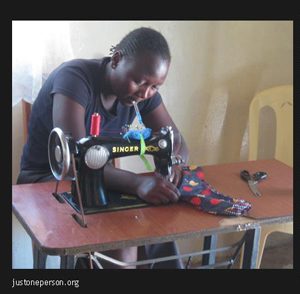
While Mwanaidi was waiting for admission to college she began sewing the “pancreas pillows” that Diabetes Education Services sells in the US. She used a donated treadle sewing machine, a pattern designed by Just One Person (JOP) Executive Director, Emma Sisia, and traditional leso cloth.
Mwanaidi joined the Just One Person (JOP) project in rural Kenya after her high school recognized her potential. Mwanaidi graduated from high school in 2010 and subsequently, became a certified chef. She uses the income from her job to help support her family of 7 siblings along with her mother and father.
All Pancreas Partner profits are donated to www.justoneperson.org.
After paying Mwanaidi for her beautiful work, Diabetes Education Services donates the profit from the sale of the Pancreas Pillow to help fund school scholarships and seminars for other girls in rural Kenya. Other alumnae of JOP have followed suit and are continuing to produce these wonderful pillows to help ensure the sustainability of our program.
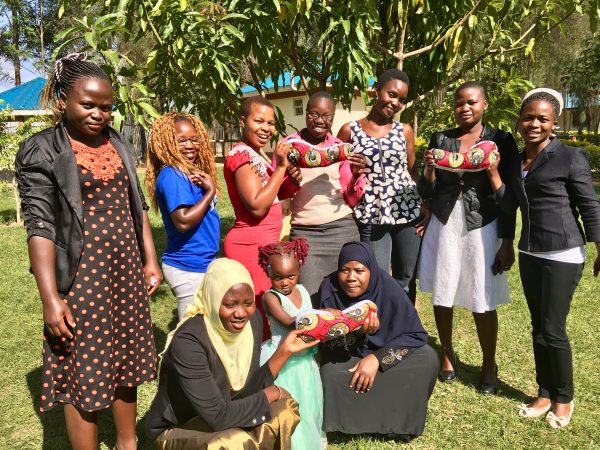
Just One Person’s philosophy is that girls are members of our organization for life. They are committed to sharing their knowledge and resources with their mothers, sisters, neighbors, and daughters for generations to come.
Sign up for Diabetes Blog Bytes – we post one daily Blog Byte from Monday to Friday. And of course, Tuesday is our Question of the Week. It’s Informative and FREE! Sign up below!
[yikes-mailchimp form=”1″]Accreditation: Diabetes Education Services is an approved provider by the California Board of Registered Nursing, Provider 12640, and Commission on Dietetic Registration (CDR), Provider DI002. Since these programs are approved by the CDR it satisfies the CE requirements for the CDCES regardless of your profession.*
The use of DES products does not guarantee the successful passage of the CDCES exam. CBDCE does not endorse any preparatory or review materials for the CDCES exam, except for those published by CBDCE.









